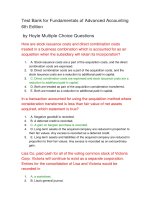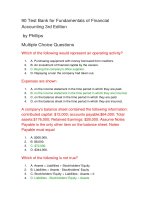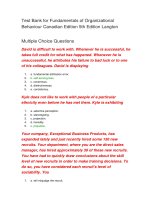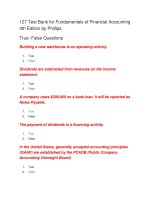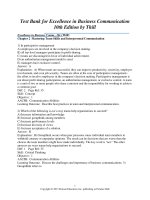Test bank for fundamentals of business law 9th edition by miller
Bạn đang xem bản rút gọn của tài liệu. Xem và tải ngay bản đầy đủ của tài liệu tại đây (66.16 KB, 25 trang )
Chapter 1
The Legal and Constitutional
Environment of Business
N.B.: TYPE indicates that a question is new, modified, or unchanged,
as follows.
N
A question new to this edition of the Test Bank.
+ A question modified from the previous edition of the Test
Bank,
= A question included in the previous edition of the Test Bank.
TRUE/FALSE QUESTIONS
1.
Constitutional law includes only the U.S. Constitution.
ANSWER: F
NAT: AACSB Analytic
2.
TYPE:
N
PAGE:
4
AICPA Legal
TYPE:
N
A state law that conflicts with the U.S. Constitution will be deemed
unconstitutional.
ANSWER: T
NAT: AACSB Analytic
4.
4
AICPA Legal
A federal law that conflicts with the U.S. Constitution will be deemed
unconstitutional.
ANSWER: T
NAT: AACSB Analytic
3.
PAGE:
PAGE:
4
AICPA Legal
TYPE:
N
A state constitution is supreme within the state’s borders so long as it
does not conflict with the U.S. Constitution or a federal law.
1
2
UNIT ONE: THE LEGAL ENVIRONMENT OF BUSINESS
ANSWER: T
NAT: AACSB Analytic
PAGE:
4
AICPA Legal
TYPE:
N
FULL FILE AT HTTP://TESTBANKSSTORE.EU/TEST-BANK-FOR-FUNDAMENTALS-OF-BUSINESSLAW-9TH-EDITION-BY-MILLER
5.
The U.S. Constitution is the supreme law of the United States.
ANSWER: T
NAT: AACSB Analytic
6.
TYPE:
N
PAGE:
4
AICPA Legal
TYPE:
N
PAGE:
5
AICPA Legal
TYPE:
N
PAGE:
5
AICPA Legal
TYPE:
N
PAGE:
5
TYPE:
AICPA Critical Thinking
N
Common law is not a source of legal authority.
ANSWER: F
NAT: AACSB Analytic
12.
4
AICPA Legal
Common law is a term for social manners and customs that are
familiar to most of us.
ANSWER: F
NAT: AACSB Analytic
11.
PAGE:
Federal administrative agencies specify the powers of Congress.
ANSWER: F
NAT: AACSB Analytic
10.
N
Every state has adopted the Uniform Commercial Code in its entirety.
ANSWER: F
NAT: AACSB Reflective
9.
TYPE:
Uniform laws apply in all states, including those in which the laws
have not been adopted.
ANSWER: F
NAT: AACSB Analytic
8.
4
AICPA Legal
Whether a law is constitutional depends on its source.
ANSWER: F
NAT: AACSB Analytic
7.
PAGE:
PAGE:
5
AICPA Legal
TYPE:
N
A decision on a given issue by a court is not binding on an inferior
court.
ANSWER: F
NAT: AACSB Analytic
PAGE:
6
AICPA Legal
TYPE:
N
4
13.
UNIT ONE: THE LEGAL ENVIRONMENT OF BUSINESS
Judges use precedent when deciding a case in a common law legal
system.
ANSWER: T
NAT: AACSB Analytic
14.
TYPE:
N
PAGE:
7
AICPA Legal
TYPE:
N
PAGE:
7
AICPA Legal
TYPE:
N
PAGE:
7
AICPA Legal
TYPE:
N
PAGE:
7
AICPA Legal
TYPE:
N
Equitable remedies include injunctions and decrees of specific
performance.
ANSWER: T
NAT: AACSB Analytic
20.
7
AICPA Legal
A substantive law creates or defines legal rights and obligations.
ANSWER: T
NAT: AACSB Analytic
19.
PAGE:
In most states, a court can grant legal remedies or equitable
remedies, but not both in the same case.
ANSWER: F
NAT: AACSB Analytic
18.
N
Monetary damages is a remedy at law.
ANSWER: T
NAT: AACSB Analytic
17.
TYPE:
A defendant is a person against whom a lawsuit is brought.
ANSWER: T
NAT: AACSB Analytic
16.
6
AICPA Legal
Equity is a branch of law that seeks to supply remedies other than
damages.
ANSWER: T
NAT: AACSB Analytic
15.
PAGE:
PAGE:
9
AICPA Legal
TYPE:
N
The federal government cannot regulate commerce within a state,
even if the commerce concerns more than one state.
FULL FILE AT HTTP://TESTBANKSSTORE.EU/TEST-BANK-FOR-FUNDAMENTALS-OF-BUSINESSLAW-9TH-EDITION-BY-MILLER
ANSWER: F
NAT: AACSB Analytic
21.
11
TYPE:
AICPA Critical Thinking
N
The state governments retain all powers not specifically delegated to
the federal government.
ANSWER: T
NAT: AACSB Analytic
22.
PAGE:
PAGE:
12
AICPA Legal
TYPE:
N
Local governments, including cities, can exercise police powers.
ANSWER: T
NAT: AACSB Analytic
PAGE:
12
TYPE:
AICPA Critical Thinking
N
6
23.
UNIT ONE: THE LEGAL ENVIRONMENT OF BUSINESS
When state regulations impinge on interstate commerce, commerce
must yield to the regulations.
ANSWER: F
NAT: AACSB Analytic
24.
N
PAGE:
12
AICPA Legal
TYPE:
+
PAGE:
12
TYPE:
AICPA Critical Thinking
+
PAGE:
14
TYPE:
AICPA Critical Thinking
+
PAGE:
14
TYPE:
AICPA Critical Thinking
N
Political speech that would otherwise be protected by the First
Amendment is prohibited if its source is a corporation.
ANSWER: F
NAT: AACSB Reflective
30.
TYPE:
A restriction on commercial speech that implements a substantial
government interest may be valid.
ANSWER: T
NAT: AACSB Analytic
29.
12
AICPA Legal
The First Amendment does not protect commercial speech as
extensively as noncommercial speech.
ANSWER: T
NAT: AACSB Reflective
28.
PAGE:
The First Amendment protects symbolic speech.
ANSWER: T
NAT: AACSB Reflective
27.
N
The Bill of Rights protects individuals against various types of
interference by the states.
ANSWER: T
NAT: AACSB Analytic
26.
12
TYPE:
AICPA Critical Thinking
The federal government retains all powers not specifically delegated
to the states.
ANSWER: F
NAT: AACSB Analytic
25.
PAGE:
PAGE:
14
TYPE:
AICPA Critical Thinking
The First Amendment protects obscene speech.
N
FULL FILE AT HTTP://TESTBANKSSTORE.EU/TEST-BANK-FOR-FUNDAMENTALS-OF-BUSINESSLAW-9TH-EDITION-BY-MILLER
ANSWER: F
NAT: AACSB Reflective
PAGE:
15
TYPE:
AICPA Critical Thinking
N
8
31.
UNIT ONE: THE LEGAL ENVIRONMENT OF BUSINESS
A federal law that promotes a religion is unconstitutional.
ANSWER: T
NAT: AACSB Analytic
32.
+
PAGE:
18
AICPA Legal
TYPE:
+
PAGE:
18
AICPA Legal
TYPE:
N
A reference to “28 U.S.C. Section 1332” means that a federal court’s
decision can be found on Page 28 of Section 1332 of the United
States Cases.
ANSWER: F
NAT: AACSB Analytic
35.
TYPE:
A law that restricts a fundamental right violates substantive due
process regardless of the type of state interest that the law
“promotes.”
ANSWER: F
NAT: AACSB Analytic
34.
16
AICPA Legal
A law that restricts a fundamental right does not violate substantive
due process if it promotes a compelling state interest.
ANSWER: T
NAT: AACSB Analytic
33.
PAGE:
PAGE:
24
TYPE:
AICPA Research
N
Rules and regulations adopted by federal administrative agencies are
compiled in the Code of Federal Regulations.
ANSWER: T
NAT: AACSB Analytic
PAGE:
24
TYPE:
AICPA Research
N
MULTIPLE-CHOICE QUESTIONS
1.
Voters in North Carolina approve a new state constitution, after which
the Ocean City Council passes new ordinances, the North Carolina
Department of Parks and Recreation issues new rules, and the Ocean
City Chamber of Commerce sends out new instructions. Sources of
law do not include
a.
b.
instructions issued by the Ocean City Chamber of Commerce.
ordinances passed by the Ocean City Council.
FULL FILE AT HTTP://TESTBANKSSTORE.EU/TEST-BANK-FOR-FUNDAMENTALS-OF-BUSINESSLAW-9TH-EDITION-BY-MILLER
c.
d.
rules issued by the North Carolina Department of Parks and
Recreation.
state constitutions passed by popular vote.
ANSWER: A
NAT: AACSB Reflective
2.
N
PAGE:
4
AICPA Legal
TYPE:
N
The U.S. Congress enacts a new federal statute that sets different
standards for the liability of businesses selling defective products.
This statute applies
a.
b.
c.
d.
only to matters not covered by state law.
only to those states that adopt the statute.
to all of the states.
to none of the states.
ANSWER: C
NAT: AACSB Reflective
PAGE:
4
AICPA Legal
TYPE:
N
The River City Council, the Santa Clara County Board, the Texas state
legislature, and the U.S. Congress enact laws. These laws constitute
a.
b.
c.
d.
administrative law.
case law.
stare decisis.
statutory law.
ANSWER: D
NAT: AACSB Reflective
5.
TYPE:
neither provision applies.
the provisions are balanced to reach a compromise.
the state constitution takes precedence.
the U.S. Constitution takes precedence.
ANSWER: D
NAT: AACSB Reflective
4.
4
AICPA Legal
If a provision in the Florida state constitution conflicts with a
provision in the U.S. Constitution
a.
b.
c.
d.
3.
PAGE:
PAGE:
4
TYPE:
AICPA Critical Thinking
N
Mary is a consultant to the National Conference of Commissioners on
Uniform State Laws. This organization
10
UNIT ONE: THE LEGAL ENVIRONMENT OF BUSINESS
a.
b.
c.
d.
adopts uniform laws for the states.
applies uniform laws to the states.
drafts uniform laws for adoption by the states.
imposes uniform laws on the states.
ANSWER: C
NAT: AACSB Reflective
PAGE:
4
TYPE:
AICPA Critical Thinking
N
FULL FILE AT HTTP://TESTBANKSSTORE.EU/TEST-BANK-FOR-FUNDAMENTALS-OF-BUSINESSLAW-9TH-EDITION-BY-MILLER
6.
The Uniform Commercial Code has been adopted, at least in part, in
a.
b.
c.
d.
all states.
forty-five states.
twenty-five states.
no states.
ANSWER: A
NAT: AACSB Reflective
7.
TYPE:
N
all law that affects a business’s operation.
decisions, orders, and rules of the FTC.
ordinances enacted by county board and the city council.
statutes enacted by the state legislature.
ANSWER: B
NAT: AACSB Reflective
PAGE:
5
AICPA Legal
TYPE:
N
Areas of the law not governed by statutory or administrative law are
a.
b.
c.
d.
governed by the common law.
open to each individual’s own interpretation.
regulated by the states under the U.S. Constitution.
subject to local ordinances.
ANSWER: A
NAT: AACSB Analytic
9.
5
AICPA Legal
The Federal Trade Commission (FTC) is a government agency that
issues rules, orders, and decisions. The Georgia state legislature
enacts statutes. The Jackson County Board and the Peach City
Council enacts ordinances. Administrative law includes
a.
b.
c.
d.
8.
PAGE:
PAGE:
5
AICPA Legal
TYPE:
N
The “common law” is referred to as the common law because
a.
b.
c.
d.
it consists of social manners and customs familiar to most of
us.
it was originally applied only to commoners in England.
it was more or less uniform throughout England.
it focuses on minor, common violations.
ANSWER: C
NAT: AACSB Reflective
PAGE:
6
AICPA Legal
TYPE:
N
12
UNIT ONE: THE LEGAL ENVIRONMENT OF BUSINESS
FULL FILE AT HTTP://TESTBANKSSTORE.EU/TEST-BANK-FOR-FUNDAMENTALS-OF-BUSINESSLAW-9TH-EDITION-BY-MILLER
10.
The federal government and the state governments constitute the
U.S. legal system. This system is based on the legal system of
a.
b.
c.
d.
Ancient Greece.
Ancient Rome.
England.
France.
ANSWER: C
NAT: AACSB Reflective
11.
TYPE:
N
administrative regulations.
court decisions.
federal and state statutes.
proposed uniform laws.
ANSWER: B
NAT: AACSB Reflective
PAGE:
6
AICPA Legal
TYPE:
N
Kurt is a judge hearing the case of Local Co. v. Macro Corp. Applying
the relevant rule of law to the facts of the case requires Kurt to find
previously decided cases that, in relation to the case under consideration, are
a.
b.
c.
d.
as different as possible.
as similar as possible.
at odds.
exactly identical.
ANSWER: B
NAT: AACSB Reflective
13.
6
AICPA Legal
As a judge, Sylvia applies common law rules. These rules develop
from
a.
b.
c.
d.
12.
PAGE:
PAGE:
6
TYPE:
AICPA Critical Thinking
N
Dixie is a victim of Enoch’s violation of a criminal law. Criminal law is
concerned with
a.
b.
c.
d.
the prosecution of private individuals by other private
individuals.
the prosecution of public officials by private individuals.
the relief available when a person’s rights are violated.
wrongs committed against the public as a whole.
14
UNIT ONE: THE LEGAL ENVIRONMENT OF BUSINESS
ANSWER: D
NAT: AACSB Reflective
PAGE:
9
AICPA Legal
TYPE:
N
FULL FILE AT HTTP://TESTBANKSSTORE.EU/TEST-BANK-FOR-FUNDAMENTALS-OF-BUSINESSLAW-9TH-EDITION-BY-MILLER
14.
In a suit against Kathy, Lon obtains specific performance. This is
a.
b.
c.
d.
an equitable remedy and a remedy at law.
an equitable remedy only.
a remedy at law only.
not a remedy.
ANSWER: B
NAT: AACSB Reflective
15.
d.
TYPE:
N
the laws of individual nations only.
treaties and international organizations only.
the laws of individual nations, and treaties and international
organizations.
none of the choices.
ANSWER: C
NAT: AACSB Reflective
PAGE:
10
AICPA Legal
TYPE:
N
Household Furnishings, Inc., distributes its merchandise on an interstate basis. Under the commerce clause, Congress has the power to
regulate
a.
b.
c.
d.
any commercial activity in the United States that substantially
affects interstate commerce.
only activities that are in intrastate commerce.
only activities that are in local commerce.
only activities that are not in commerce.
ANSWER: A
NAT: AACSB Analytic
17.
9
AICPA Legal
When Oceania, Inc., based in New York, does business internationally,
the firm may be subject to international law. The sources of this law
include
a.
b.
c.
16.
PAGE:
PAGE:
10
AICPA Legal
TYPE:
N
Miles, the president of Nano Games Corporation, claims that certain
actions by the federal government and the state of Oklahoma
infringe on rights guaranteed by the Bill of Rights. Most of these
rights limit actions by
a.
b.
neither Oklahoma nor the federal government.
Oklahoma and the federal government.
16
UNIT ONE: THE LEGAL ENVIRONMENT OF BUSINESS
c.
d.
Oklahoma only.
the federal government only.
ANSWER: B
NAT: AACSB Reflective
18.
c.
d.
N
imposes a substantial burden on interstate commerce.
promotes the public order, health, safety, morals, or general
welfare.
regulates activities within Utah’s borders.
regulates private activities.
ANSWER: A
NAT: AACSB Reflective
PAGE:
12
TYPE:
N
AICPA Decision Modeling
Dian, a U.S. citizen, is the owner of Elemental Foods, Inc. The Bill of
Rights embodies a series of protections for Dian against various types
of interference by
a.
other business entities only.
b.
private individuals only.
c.
the government only.
d.
other business entities,
government.
ANSWER: C
NAT: AACSB Reflective
20.
12
TYPE:
AICPA Critical Thinking
Tom files a suit against the state of Utah, claiming that a Utah state
law violates the commerce clause. The court will agree if the statute
a.
b.
19.
PAGE:
PAGE:
private
individuals,
12
AICPA Legal
TYPE:
and
the
N
The police obtain a search warrant and search Dave’s apartment.
After yelling obscenities at the officers, Dave confesses to a crime
and implicates his friends. The Constitution protects against
a.
obscene speech only.
b.
implication of others only.
c.
unreasonable searches only.
d.
obscene speech, implication of others, and unreasonable
searches.
ANSWER: C
NAT: AACSB Reflective
PAGE:
12
AICPA Legal
TYPE:
N
FULL FILE AT HTTP://TESTBANKSSTORE.EU/TEST-BANK-FOR-FUNDAMENTALS-OF-BUSINESSLAW-9TH-EDITION-BY-MILLER
21.
Franco, the president of GigaSales Company, claims that certain
actions by the federal government and by the state of Idaho infringe
on rights guaranteed by the Bill of Rights. All of these rights limit
actions by
a.
b.
c.
d.
Idaho and the federal government.
Idaho only.
neither Idaho nor the federal government.
the federal government only.
ANSWER: D
NAT: AACSB Reflective
22.
+
little protection.
no protection.
significant protection.
total protection.
ANSWER: C
NAT: AACSB Reflective
PAGE:
14
TYPE:
AICPA Critical Thinking
N
Indiana enacts a statute that bans the distribution of anonymous
political leaflets. A court would likely hold this to be
a.
b.
c.
d.
an unconstitutional restriction of speech.
constitutional under the First Amendment.
justified by the need to protect individual rights.
necessary to protect state interests.
ANSWER: A
NAT: AACSB Reflective
24.
12
TYPE:
AICPA Critical Thinking
Emergent Power Corporation regularly expresses opinions on political
issues. Under the First Amendment, corporate political speech is
given
a.
b.
c.
d.
23.
PAGE:
PAGE:
14
TYPE:
AICPA Critical Thinking
N
California enacts a statute to ban advertising in “bad taste.” This
statute would likely be held by a court to be
a.
b.
c.
an unconstitutional restriction of speech.
constitutional under the First Amendment.
justified by the need to protect individual rights.
18
UNIT ONE: THE LEGAL ENVIRONMENT OF BUSINESS
d.
necessary to protect state interests.
ANSWER: A
NAT: AACSB Reflective
25.
an unconstitutional restriction of speech.
constitutional under the First Amendment.
justified by the need to protect individual rights.
necessary to protect national interests.
ANSWER: A
NAT: AACSB Reflective
PAGE:
14
TYPE:
+
AICPA Decision Modeling
Machismo Motor Sales Corporation regularly advertises its off-theroad and all-terrain vehicles and other products. Under the First
Amendment, these ads and other commercial speech are given
a.
b.
c.
d.
less protection than noncommercial speech.
more protection than symbolic speech.
no protection.
the same protection as defamatory speech.
ANSWER: A
NAT: AACSB Reflective
27.
14
TYPE:
+
AICPA Decision Modeling
Congress enacts the Tight Money Act (TMA) of 2009 to prohibit
“major business entities” from making political contributions that
individuals can make. A court would likely hold the TMA to be
a.
b.
c.
d.
26.
PAGE:
PAGE:
14
TYPE:
AICPA Critical Thinking
N
Dribble Beers, Inc., markets alcoholic beverages. A federal regulation
bans the disclosure of the alcohol content of the beverages on
Dribble’s labels and those of other marketers. A court would likely
hold this regulation to be
a.
b.
c.
d.
an unconstitutional restriction of speech.
constitutional under the First Amendment.
justified by the need to protect individual rights.
necessary to protect national interests.
ANSWER: A
NAT: AACSB Reflective
PAGE:
14
AICPA Legal
TYPE:
N
FULL FILE AT HTTP://TESTBANKSSTORE.EU/TEST-BANK-FOR-FUNDAMENTALS-OF-BUSINESSLAW-9TH-EDITION-BY-MILLER
28.
In 2009, Congress enacts the Act to Restrict Commercial Speech
(ARCS). The ARCS will be considered valid
a.
b.
c.
d.
if it directly advances a substantial government interest but
goes no further than necessary.
if it directly advances a substantial government interest regardless of how “far” it goes.
under any circumstances.
under no circumstances.
ANSWER: A
NAT: AACSB Reflective
29.
PAGE:
14
AICPA Legal
TYPE:
N
Xtreme Publications, Inc., disseminates obscene materials. Under numerous state and federal statutes, this is
a.
b.
c
d.
a
a
a
a
crime.
privilege.
right under the commerce clause.
right under the First Amendment.
ANSWER: A
NAT: AACSB Analytic
PAGE:
15
AICPA Legal
TYPE:
N
20
30.
UNIT ONE: THE LEGAL ENVIRONMENT OF BUSINESS
Ohio enacts a law requiring all businesses in the state to donate 10
percent of their profits to Protestant churches that provide certain
services to persons whose income is below the poverty level.
PriceLess Stores files a suit to block the law’s enforcement. The court
would likely hold that this law violates
a.
b.
c.
d.
no provision in the U.S. Constitution.
the commerce clause.
the First Amendment.
the due process clause.
ANSWER: C
NAT: AACSB Reflective
31.
no provision in the U.S. Constitution.
Article I’s commerce clause.
the First Amendment.
the Fifth and Fourteenth Amendment’s due process clauses.
ANSWER: D
NAT: AACSB Analytic
PAGE:
18
AICPA Legal
TYPE:
N
A Massachusetts state statute imposes a prison term, without a trial,
on all street vendors who operate in certain areas. A court would
likely hold this statute to be
a.
b.
c.
d.
constitutional.
unconstitutional under the commerce clause.
unconstitutional under the due process clause.
unconstitutional under the free exercise clause.
ANSWER: C
NAT: AACSB Reflective
33.
16
TYPE:
+
AICPA Decision Modeling
Uriah is charged with reckless driving and under Vermont state law is
notified of an opportunity to be heard before his license is
suspended. The requirement that no person be deprived of “life,
liberty, or property without due process of law” is in
a.
b.
c.
d.
32.
PAGE:
PAGE:
18
AICPA Legal
TYPE:
+
Potable Beverage Company appeals a decision against it, in favor of
Quench Thirst Corporation, from a lower court to a higher court.
Potable is
a.
the appellant.
FULL FILE AT HTTP://TESTBANKSSTORE.EU/TEST-BANK-FOR-FUNDAMENTALS-OF-BUSINESSLAW-9TH-EDITION-BY-MILLER
b.
c.
d.
the appellee.
the defendant.
the plaintiff.
ANSWER: A
NAT: AACSB Reflective
PAGE:
30
AICPA Legal
TYPE:
N
22
34.
UNIT ONE: THE LEGAL ENVIRONMENT OF BUSINESS
The Montana Supreme Court decides the case of National Co. v.
Overseas Corp. Of nine justices, eight believe the judgment should be
in National’s favor. Justice Pine disagrees and writes a separate
opinion. This opinion is
a.
b.
c.
d.
a
a
a
a
concurring opinion.
dissenting opinion.
minority opinion.
unanimous opinion.
ANSWER: B
NAT: AACSB Analytic
35.
PAGE:
30
TYPE:
AICPA Research
N
Metro City Center is an area of tourist attractions in Metro City. The
Center’s director, under the city’s authority, issues a rule to require
street performers to obtain permits. The Center cites Nobby, a
magician, for performing without a permit. Under the principles
discussed in “A Sample Court Case,” Berger v. City of Seattle, the
Center most likely acted
a.
b.
c.
d.
in violation
reasonably
reasonably
reasonably
of Nobby’s rights under the First Amendment.
in issuing the rule but not in citing Nobby.
in citing Nobby but not in issuing the rule.
in the circumstances and under the law.
ANSWER: D
NAT: AACSB Reflective
PAGE:
31
TYPE:
AICPA Research
N
ESSAY QUESTIONS
1.
Acorn Brewery, Inc., makes and sells alcoholic beverages with labels
that display a drawing of a squirrel making the gesture generally
known as “giving the finger.” Acorn applies to the Ohio State Liquor
Authority (OSLA) for brand-label approval to sell the beer in Ohio.
Without considering alternatives, OSLA denies approval because “the
label could appear in grocery stores, with obvious exposure on the
shelf to children of tender age.” Why would a court hold that the
denial of Acorn’s application violates the First Amendment?
ANSWER: A court would most likely reason that OSLA’s ban on the
use of the labels lacks a “reasonable fit” with the state’s interest in
shielding minors from vulgarity, and OSLA did not adequately
FULL FILE AT HTTP://TESTBANKSSTORE.EU/TEST-BANK-FOR-FUNDAMENTALS-OF-BUSINESSLAW-9TH-EDITION-BY-MILLER
consider alternatives to the ban. The First Amendment protects
commercial speech. Commercial speech is not as protected as much
as noncommercial speech, however, so states can place some
restraints on the former. For example, to protect consumers, a state
may ban certain kinds of marketing practices, such as deceptive or
misleading advertising. Generally, a restriction on commercial speech
will be considered valid as long as it (1) seeks to implement a substantial government interest, (2) directly advances that interest, and
(3) goes no further than necessary to accomplish the objective. The
interest of OSLA, as a state agency, in protecting children from vulgar
advertising is “substantial.” The question is whether banning Acorn’s
labels “directly advances” that interest. A court might reason that
barring the label at issue in this problem cannot realistically be
expected to reduce children’s exposure to such displays to any
significant degree, considering such displays’ wide currency in
society. Also, as to whether the ban on the labels is more extensive
than necessary to serve such an interest, a court would likely point
out that there may be many, less intrusive alternatives. For example,
OSLA might restrict the locations where Acorn’s products may be displayed in stores.
PAGES:
14–15
NAT: AACSB Reflective
2.
TYPE: N
AICPA Decision Modeling
The Olympic Torch Relay passed through Juneau, Alaska, on its way to
the winter games in Salt Lake City, Utah, in 2002. Students at JuneauDouglas High School (JDHS) were permitted to leave class to observe
the relay. As it passed in front of the school, Joseph Frederick, a
senior, and his friends unfurled a banner bearing the phrase: “BONG
HiTS 4 JESUS.” Deborah Morse, JDHS’s principal, confiscated the
banner and suspended Frederick for ten days. Frederick’s suit against
Morse was eventually appealed to the United States Supreme Court.
The Court’s opinion in the case is at Morse v. Frederick, __ U.S. __,
147 S.Ct. 2618, 168 L.Ed.2d 290 (2007). Specifically where can this
opinion be found?
ANSWER: This case—Morse v. Frederick, __ U.S. __, 147 S.Ct. 2618,
168 L.Ed.2d 290 (2007)—can be found in its entirety in volume 147 of
the Supreme Court Reporter, on page 2618, and in volume 168 of
Lawyers’ Edition of the Supreme Court Reports, on page 290. Both
publications are unofficial editions of the decisions of the United
States Supreme Court. The opinion may also be found in United
States Reports, the official edition of the Court’s decisions, but the
24
UNIT ONE: THE LEGAL ENVIRONMENT OF BUSINESS
blank lines indicate that the volume has not yet been published and
no page numbers have yet been assigned. The Court decided this
case in 2007.
PAGES:
25 & 27
NAT: AACSB Reflective
TYPE: N
AICPA Legal
